|

|
Post production: Storage
|

|
|
|
|
|
|

|
Storage pests: Insects, Rodents and fungi
|
|
|
|
|
|
|
![obj[1]](obj_1_.gif)
|
Identify different insects (primary insects and secondary insects) that attack stored grain
|
|
|
|
|
|
Pests cause losses
|
What are the main pests in storage?
-
Insects
-
Rodents (and birds)
-
Fungi
Pests cause losses because they can eat, spoil orcontaminate the paddy or milled grain.
|
|
|
|
A. Insects
Many different species of insects are found in rice but only a few are a big problem. Insects in stored rice can be classified as either primary orsecondary insects. Primary insects are a bigger problem than secondary insects. Primary insects damage the grain more than secondary insects because they eat the inside of the grain first. Secondary insects eat the grain from the outside first.
Primary insects
|
|
1. Rice Weevil
(Sitophilos oryzae (Linnaeus))
Click for more info Adults and larvae feed on grains. A female lays up to 150 eggs. A single egg is laid in each grain after making a hole inside. The egg stays in the grain until it becomes an adult. This insect completely damages the grain.
|
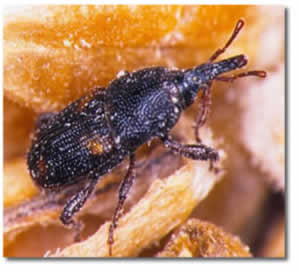
|
|
2. Angoumois Grain Moth
(Sitatroga cerealella (Olivier))
Click for more info Eggs are laid on or near the grain. The white larvae bore into the kernels and eat the inside. Mature larvae eat their way to the outer portion of the grain, leaving only a thin layer of the outer seed coat intact. Adults damage only the surface layer of bulk-stored grain, because adults are unable to penetrate deeply.
|
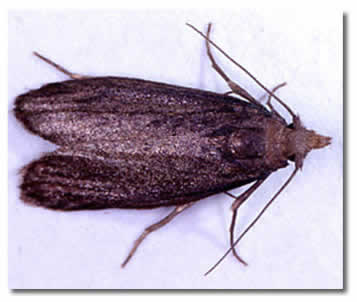
|
|
3. Lesser Grain Borer
(Rhyzopertha dominica (Fabricus)
Click for more info The eggs are laid in the grain mass. Larvae may enter the kernels and develop within or may feed externally in the flour-like dust that builds up from the feeding of the adults and other larvae.
|
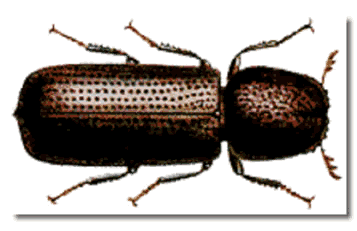
|
Secondary insects
|
|
4. Saw-toothed Grain Beetle
(Oryzaephilus surinamensis (Linnaeus))
Click for more info Eggs are usually laid, either one by one or in small groups in a crack in the grain but in products such as flour they are laid freely.
|
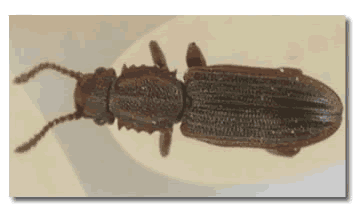
|
|
5. Rust-red flour beetle
(Tribolium castaneum)
Click for more info Mainly attacks milled grain products. Adults and larvae feed only on the grain dust and broken kernels and do not attack the undamaged whole kernels. Infestation leads to constant and unpleasant smell of the rice.
|
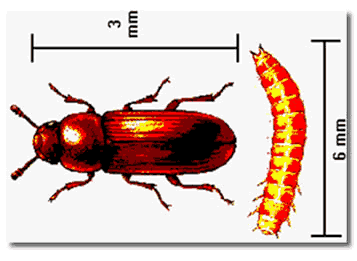
|
|
|
|
|
B. Rodents:What are rodents?
With rodents we mean mainly rats and mice.

A mouse (left) is usually much smaller than a rat (right)
|
|
|
Why are rodents a problem?
|

|
1. Rodents eat the stored grain: Rats eat about 25 grams of paddy or rice per day and mice eat 3-4 grams per day.
|
|

|
2. Rodents make the stored grain filthy:They infect a lot of the stored rice with urine, feces, hair and pathogenic agents (diseases). Infested batches of rice are often declared unhealthy for human consumption.
|
|

|
3. Rodents damage material and equipment:Rodents damage covers, bags, pallets, sprayers, and the store itself (cables, doors, etc).
Click for examples - bags leak grain when rodents bite holes in them
- bag stacks can collapse when rodents bite on the supporting frames
- sparks from short circuits can cause a fire when rodents bite on electrical wires
- silos and warehouses may sink or even fall down as a result of being undermined by rodent tunnels
- drainage canals around a store can get damaged.
|
|
|
|
How can you keep rodents out of your storage?
|
|
|
|
1. Preventive measures:
When you build a new storage, you must think about the ways to keep rodents out of your storage.
Click for more information
|

Store bags in tidy stacks on pallets, with a space of 1 meter all round the stack!
|
2. Maintain the storage properly
Click for more information - Keep the store very clean! Remove any fallen grain immediately!
- Store bags in tidy stacks set up on pallets, ensuring that there is a space of 1 meter all round each stack!
- Store any empty or old bags and fumigation sheets on pallets, and if possible in separate stores!
- Keep the store free of garbage in order not to provide the animals with places to hide or nest!
- Burn or bury garbage!
- Keep the area around the storage free of tall weeds. Tall weeds give the animals cover! They don't like to cross open spaces.
- Keep the area around the storage free of any stagnant water and make sure that rainwater is drained away. The rodents might use this for drinking water.
|
|
|
|
Exercise: Click and drag every picture to the right box!
|
|
|
C. Storage fungi
The most common storage fungi in rice are species of Aspergillus and Penicillium.
Storage fungi are molds that usually attack grain or seed during storage. They are generally not present in large amounts before harvest in the field.
The grain gets contaminated through spores of the fungi. Sometimes there already are some spores on the grain before it goes into storage. Sometimes there are spores on the equipment or in the storage structure. If temperatures and moisture are high contamination can go fast.
|
|
|
What are the problems of fungi in storages?
Grain gets spoiled from fungal growth or molds
|
Grain spoilage results in:
|
|

|
|
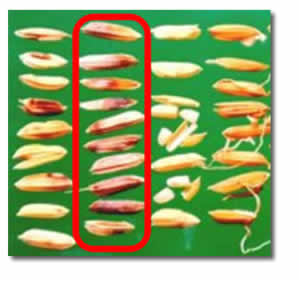
Discoloration of grain
|
|

|
|
|

|
|
|

|
|
|

|
|
|

|
|
|
|
|
What can you do against fungi?
|
|
|
Next lesson
|
|

|

![obj[1]](obj_1_.gif)








